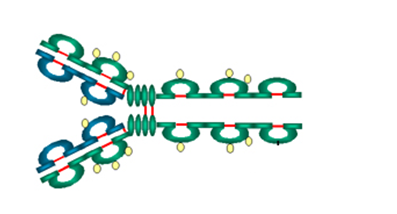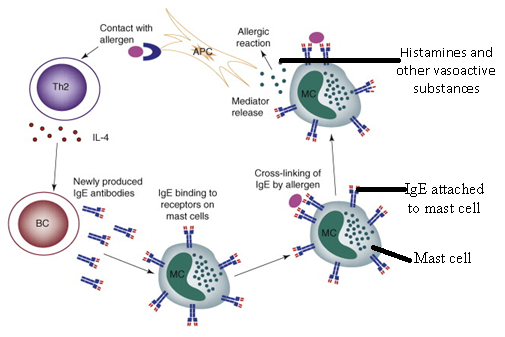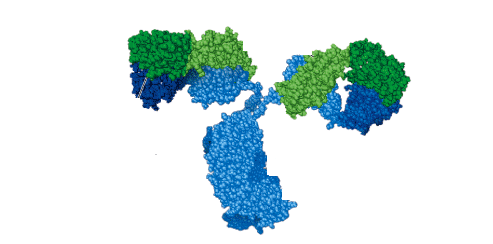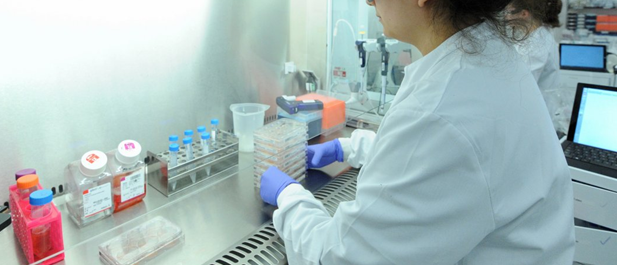Immunoglobulin E (IgE) is an antibody that is known to bind to host tissue cells (e.g. mast cells), and it is largely responsible for most hypersensitivity reactions (i.e. allergy) in the body. Some of the symptoms of the allergic reactions mediated by IgE response to the invasion of antigens include anaphylactic shock, hay fever and asthma. IgE has a structure similar to the generalized immunoglobulin structure; and it is made up of two pairs of heavy and light chains that are joined by disulfide bonds (Figure 1). The type of allergic reaction mediated by IgE is known as Type I hypersensitivity reaction.
Type I hypersensitivity reaction which can also be called anaphylactic or atopic hypersensitivity is an IgE-mediated type of immediate allergic reaction that provides a systemic or local protective functions at various body sites especially on the skin. Immunoglobulin E is specifically bound to the Fc receptors found on mast cells; and it controls the activities of the mucosal associated lymphoid tissue (MALT) which provides protective functions around various mucous membrane surfaces in the body (inclusive of the nasal area, oral cavity and intestinal mucosal surfaces).
Immunoglobulin E is the main protective antibody against parasites or helminthes; and they do not cross the placental barrier. However, IgE activates the complement system by the alternative pathway. IgE exist in serum at a relatively low level, and the antibody has a MW of about 190, 000 DA.
The allergic reactions mediated by IgE response to the invasion of antigens leads to the release of pharmacologically active mediators (e.g. histamines, leukotrienes and prostaglandins) by the mast cells; and it is these pharmacologically active substances released by the mast cells that are largely responsible for the hypersensitivity reactions associated with IgE function.
Also, the pharmacologically active mediators facilitate the release and buildup of other immune system cells and molecules that are required to defend the body against parasitic infections. The reaction that goes on between the binding of IgE to mast cells and the release of vasoactive substances by basophils is shown in Figure 2.

IgE has a high affinity for mast cells (e.g. basophils); and the antibody is a cell membrane bound immunoglobulin that mediates hypersensitivity reactions in the body. IgE binds to the Fc region of basophils; and this result in the release of vasoactive substances (e.g. histamines) following the degranulation of mast cells.

The bridging of two IgE molecules on mast cell membranes causes the release of granules and/or vasoactive substances as shown in the illustration. IgE is mainly responsible for the mediation of immediate Type I Hypersensitivity reactions that cause hay fever, asthma, hives, and anaphylactic shock; and the immunoglobulin assist in defending the body against parasitic or helminthic infections. IgE bind with high affinity to Fc receptors on the surfaces of mast cells and/or basophils; and this binding activates the degranulation of the mast cells to release vasoactive substances inclusive of histamines, cytokines, prostaglandins and leukotrienes amongst others. These pharmacologically active substances mediates Type I hypersensitivity reactions in the body.
REFERENCES
Abbas A.K, Lichtman A.H and Pillai S (2010). Cellular and Molecular Immunology. Sixth edition. Saunders Elsevier Inc, USA.
Actor J (2014). Introductory Immunology. First edition. Academic Press, USA.
Alberts B, Bray D, Johnson A, Lewis J, Raff M, Roberts K and Walter P (1998). Essential Cell Biology: An Introduction to the Molecular Biology of the Cell. Third edition. Garland Publishing Inc., New York.
Bach F and Sachs D (1987). Transplantation immunology. N. Engl. J. Med. 317(8):402-409.
Barrett J.T (1998). Microbiology and Immunology Concepts. Philadelphia, PA: Lippincott-Raven Publishers. USA.
Jaypal V (2007). Fundamentals of Medical Immunology. First edition. Jaypee Brothers Medical Publishers (P) Ltd, New Delhi, India.
John T.J and Samuel R (2000). Herd Immunity and Herd Effect: New Insights and Definitions. European Journal of Epidemiology, 16:601-606.
Levinson W (2010). Review of Medical Microbiology and Immunology. Twelfth edition. The McGraw-Hill Companies, USA.
Roitt I, Brostoff J and Male D (2001). Immunology. Sixth edition. Harcourt Publishers Limited, Spain.
Zon LI (1995). Developmental biology of hematopoiesis. Blood, 86(8): 2876–91.
Discover more from Microbiology Class
Subscribe to get the latest posts sent to your email.




